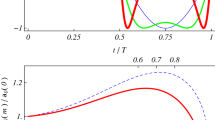Abstract
The resonating properties of the electrochemical interface are studied under harmonic perturbations in galvanostatic control and under chaotic perturbations in potentiostatic control. The resonance conditions in galvanostatic control are derived analytically and explored numerically. The theoretical findings are confirmed experimentally for the Ni | 1 M H2SO4 system. The implementation of a Rössler and a Chua chaotic perturbation to an electrochemical resonator is explored numerically. It is shown that the electrochemical resonator acts effectively as a band pass filter thus enhancing the periodicity of the chaotic input.












Similar content being viewed by others
References
Karantonis A, Karaoulanis D (2011) Conditions of electrochemical resonance under potentiostatic control. Electrochim Acta 56:4119–4125
Karantonis A, Karaoulanis D (2012) Electrical resonance and antiresonance of the electrochemical interface under potentiostatic control: theoretical considerations. Electrochim Acta 78:244–250
Rotstein HG (2013) Preferred frequency responses to oscillatory inputs in an electrochemical cell model: linear amplitude and phase resonance. Phys Rev E 88:062913
Berthier F, Diard JP, Le Gorrec B, Montella C (1998) Discontinuous immitance due to a saddle node bifurcation I: 1-, 2- and 3-part immitance diagrams. J Electroanal Chem 458:231–240
Berthier F, Diard JP, Montella C (1999) Hopf bifurcation and sign of the transfer resistance. Electrochim Acta 44:2397–2404
Koper MTM (1992) The theory of electrochemical instabilities. Electrochim Acta 37:1771–1778
Koper MTM (1996) Stability study and categorization of electrochemical oscillators by impedance spectroscopy. J Electroanal Chem 409:175–182
Kiss IZ, Gáspár V, Nyikos K (1998) Stability analysis of the oscillatory electrodissolution of copper with impedance spectroscopy. J Phys Chem B 102:909–914
Kiss IZ, Hudson JL, Santos G, Parmananda P (2003) Experiments on coherence resonance: noisy precursors to Hopf bifurcations. Phys Rev E 67:035201
Santos G, Rivera M, Parmananda P (2004) Experimental evidence of coexisting periodic stochastic resonance and coherence resonance phenomena. Phys Rev Lett 92:230–601
Santos G, Rivera M, Escalona J, Parmananda P (2008) Interaction of noise with excitable dynamics. Phys Trans Royal Soc A 366:369–380
Karantonis A, Bourbos E, Koutsaftis D (2010) Electrochemical resonance: frequency response analysis of the electrodissolution of copper in trifluoroacetic acid close to dynamic instabilities. Chem Phys Lett 490:69–71
Karantonis A, Bourbos E, Karaoulanis D (2013) Experiments on electrical resonance and antiresonance of the electrochemical interface under potentiostatic control. Electrochim Acta 87:912–917
Doss KSG, Deshmukh D (1976) Electrochemical potential oscillations: The nickel-sulphuric acid system. J Electroanal Chem 70:141–156
Haim D, Lev O, Pismen LM, Sheintuch M (1992) Modeling periodic and chaotic dynamics in anodic nickel dissolution. J Phys Chem 96:2672–2681
Kiss IZ, Pelster LN, Wickramasinghe M, Yablonsky GS (2009) Frequency of negative differential resistance electrochemical oscillators: theory and experiments. Phys Chem Chem Phys 11:5720–5728
Koper M, Sluyters JH (1993) A mathematical model for current oscillations at the active-passive transition in metal electrodissolution. J Electroanal Chem 347:31–48
Rössler OE (1976) An equation for continuous chaos. Phys Lett 57A:397–398
Chua LO, Komuro M, Matsumoto T (1986) The double scroll family. IEEE Trans Circ Syst 33:1073–1118
Author information
Authors and Affiliations
Corresponding author
Rights and permissions
About this article
Cite this article
Karaoulanis, D., Chryssafidis, P. & Karantonis, A. Electrochemical resonance under harmonic current perturbations and chaotic potential perturbations. J Solid State Electrochem 19, 3277–3286 (2015). https://doi.org/10.1007/s10008-015-2794-y
Received:
Revised:
Accepted:
Published:
Issue Date:
DOI: https://doi.org/10.1007/s10008-015-2794-y




